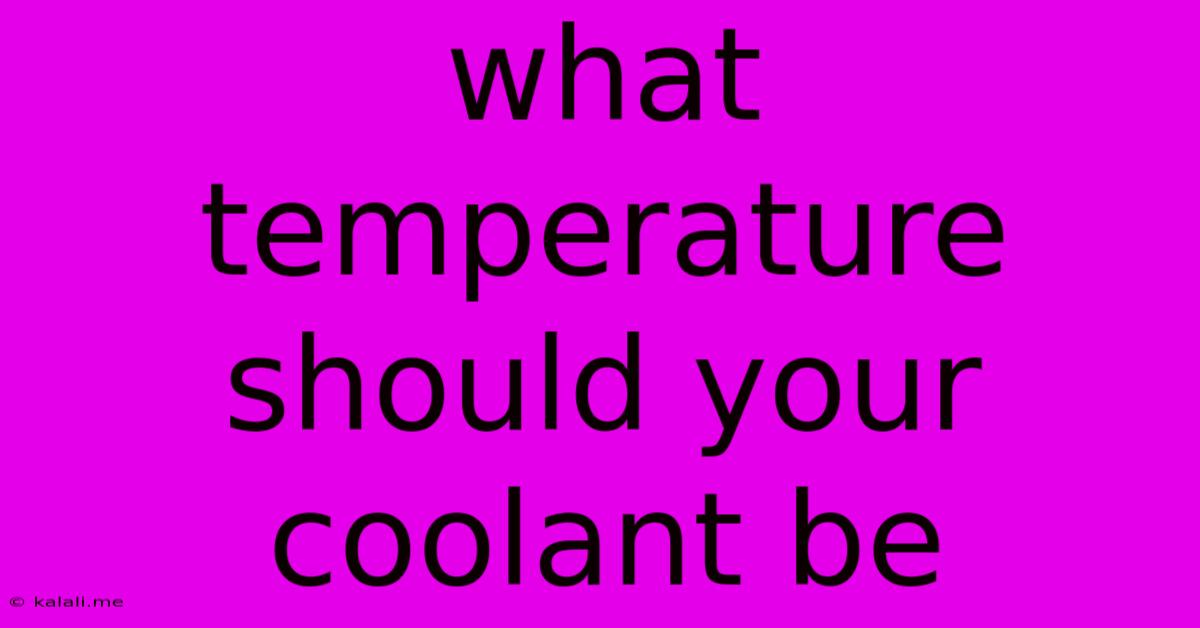What Temperature Should Your Coolant Be
Kalali
May 21, 2025 · 3 min read

Table of Contents
What Temperature Should Your Coolant Be? A Comprehensive Guide
Knowing your engine coolant temperature is crucial for maintaining your vehicle's health and preventing costly repairs. This guide will explain the ideal operating temperature range, what causes deviations, and the signs of potential problems. Understanding these factors will empower you to proactively address issues before they escalate.
Ideal Coolant Temperature Range
The optimal operating temperature for most vehicle coolant systems is between 195°F and 220°F (90°C and 104°C). This temperature range ensures efficient combustion and prevents overheating. While the exact ideal temperature might slightly vary depending on the make and model of your vehicle, staying within this general range is key. Your vehicle's thermostat plays a critical role in maintaining this temperature.
Factors Affecting Coolant Temperature
Several factors influence your engine's coolant temperature:
- Thermostat: The thermostat acts as a valve, regulating coolant flow to maintain the optimal operating temperature. A malfunctioning thermostat can lead to either consistently low or high coolant temperatures.
- Coolant Level: Low coolant levels restrict heat transfer, causing the engine to overheat. Regularly checking and maintaining the correct coolant level is essential.
- Radiator: The radiator dissipates heat from the coolant. A clogged or damaged radiator will impair its ability to cool the engine effectively, leading to higher temperatures.
- Water Pump: The water pump circulates the coolant throughout the engine. A faulty water pump will hinder proper cooling, potentially resulting in overheating.
- Ambient Temperature: Extreme outside temperatures (very hot or very cold) can impact coolant temperature. Hot weather requires more efficient cooling, while very cold weather can slow down the warming process.
- Driving Conditions: Heavy traffic or driving uphill puts extra strain on the engine, generating more heat and potentially pushing coolant temperatures higher.
Signs of Incorrect Coolant Temperature
Several warning signs indicate that your coolant temperature is outside the ideal range:
- Overheating: Symptoms include steam coming from the hood, the temperature gauge reaching the red zone, or the engine overheating warning light illuminating. This is a serious issue requiring immediate attention.
- Engine Running Cold: If the engine takes excessively long to reach its operating temperature or the temperature gauge remains consistently low, it could point to a faulty thermostat or other cooling system issues. Poor fuel efficiency and increased emissions can also be associated with a consistently cold engine.
- Temperature Gauge Fluctuations: Erratic fluctuations in the temperature gauge could indicate problems with the thermostat, water pump, or radiator.
Maintaining Optimal Coolant Temperature
Regular maintenance is vital in maintaining the correct coolant temperature:
- Regular Coolant Flushes: Periodic coolant flushes remove contaminants and ensure efficient heat transfer. The frequency of flushes depends on the vehicle's age and usage, but typically every 2-3 years or according to the manufacturer's recommendations is advisable.
- Inspecting Hoses and Belts: Visually check the condition of hoses and belts for cracks or wear. Damaged components can compromise the cooling system's efficiency.
- Regularly Checking Coolant Level: Make it a habit to check your coolant level regularly and top it off if needed, using the correct type of coolant for your vehicle.
Understanding your vehicle's coolant temperature and taking proactive steps to maintain its optimal range is crucial for preventing engine damage and ensuring the longevity of your vehicle. If you encounter any issues or warning signs, consult a qualified mechanic for diagnosis and repair.
Latest Posts
Latest Posts
-
What Size Wire For 100 Amp Service
May 23, 2025
-
How Long Does A Metal Roof Last
May 23, 2025
-
White Wine Vinegar Vs White Vinegar
May 23, 2025
-
3 In 1 Out Diamond Head 3d Printer Firmware
May 23, 2025
-
How To Get The Smell Of Gas Off Your Hands
May 23, 2025
Related Post
Thank you for visiting our website which covers about What Temperature Should Your Coolant Be . We hope the information provided has been useful to you. Feel free to contact us if you have any questions or need further assistance. See you next time and don't miss to bookmark.